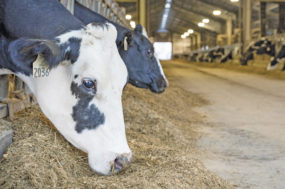Milk quality means something different for every stakeholder in the dairy industry, according to Brandon Treichler, DVM.
Treichler, who consults with more than 100 dairies as a veterinarian with Select Milk Producers, Canyon, Texas, presented “Understanding and Interpreting Bacteria Counts to Improve Milk Quality” to dairy producers attending the Great Lakes Regional Dairy Conference held in Mt. Pleasant, Michigan, earlier this year. (Treichler also serves as a member of the Progressive Dairyman editorial advisory board.)
Not only does quality mean something different for every stakeholder, the way it’s measured or perceived also differs, Treichler said.
“If you’re a producer, the first thing you go to with milk quality is somatic cell count [SCC]. If you’re a processor, bacteria counts are critical for lots of different reasons, like product safety, product quality and yield,” Treichler said. “The key party of the dairy stakeholder chain we often forget about is the consumer.
To the consumer, milk quality is something completely different and nebulous than what we think about. It’s things like, ‘How is the cow treated?’ ‘When buying this product, how does it make me feel?’ ‘Is it healthy for my family?’ ‘What kind of package is it in?’”
While it’s paramount to satisfy the consumer, and producers want to produce a desirable product, the milk quality “premium” to the dairy producer is not generated at the consumer level but at the processor level. That premium is changing.
“In the future, quality premiums will be a thing of the past,” Treichler said. “We have to transition from producing quality milk because it makes us more money, which it still will in different ways, but we have to think about it as a barrier to markets.” He posed the question, “Are you going to be able to get your milk picked up if you consistently make a 300,000 to 400,000 SCC or 8,000 bacteria count?”
Sources of bacteria
Bacteria in milk affects several factors after it leaves the farm. Food safety, shelf life, off-flavors, product yield, variations in products and the ability to export the product are all areas affected by milk quality.
There are three main sources of bacteria in milk: milk residues in the milking system, and mastitis pathogens from the cow and from the environment. While the standard plate count is the regulatory test for estimating bacterial populations in milk, it does not indicate the types or source of bacteria present, nor does it give a complete count of all types of bacteria.
Lab pasteurized count (LPC) is a more specific test used for troubleshooting sources when bacteria counts rise. LPCs select for a specific type of bacteria that live and thrive in high temperatures, including pasteurization, which are called thermoduric bacteria. “If you have an elevated LPC, it indicates a specific failure in the system. Typically, it’s a failure to wash in the CIP [clean-in-place] system and likely a system buildup,” Treichler said.
“LPCs are crucial because if these bacteria can survive high temperatures, they can also survive the drying and powdering process,” Treichler continued. “So when we make powder, it actually concentrates the number of LPC bacteria in the milk, which is graded by spore count, and that affects the export products.” “If we want to have high-quality export product lines, then we have to have low spore counts.”
Bacteria that thrive in low temperatures, called psychotrophs, are also problematic to milk quality. The preliminary incubation count selects for psychotrophs, and this usually indicates a problem with cleaning, slow or inadequate cooling, or worn-out rubber components in the milking system. It can also come from water contaminating the milk through leaky plate cooler gaskets, water-borne bacteria and flushing lines with water at the end of a milking shift.
Poor udder preparation or a bacterial growth within the milking system can make coliform counts rise. This bacteria originates in manure and enters the milk through poor milking hygiene. Keeping the milking system clean is crucial because under optimum conditions bacteria can double every 15 minutes.
3 components of sanitation
While dairy producers are aware of the need to keep their milking equipment clean, Treichler identified specific elements of the cleaning process, highlighting three components of sanitation:
- Thermal – the optimal temperature of the water
- Chemical – having the correct cleaning products
- Mechanical – making sure the cleaning solutions are thoroughly pushed through the system, providing adequate contact time with all surfaces
Maintenance of the system is critical. Poor maintenance alters the surface to be cleaned. Rough, cracked or porous surfaces are hard to keep sanitary.
“When you have leaks in the system, this means if something can leak out, bacteria and contamination can also likely leak in,” Treichler said.
Improper maintenance also alters cooling efficiency, pumping capacity and air admission in the system.
Every dairy can make high-quality milk and, in the future, it’s not going to be an option; dairy producers are going to have to produce a high-quality product.
“It’s a complex web,” Treichler said. “Your milk might go to the same plant every day, but the components of that milk they spin off – like the whey protein concentrate and all those other pieces – go 50 different directions, and quality impacts all of those.
Don’t tolerate high bacteria counts, because you don’t need to; I promise you can make high-quality milk and hopefully you can go home and pick up a few more dollars in your milk check.” ![]()
PHOTO: The importance of milk quality is growing, even as premiums diminish. Staff photo.

-
Melissa Hart
- Freelance Writer
- North Adams, Michigan







